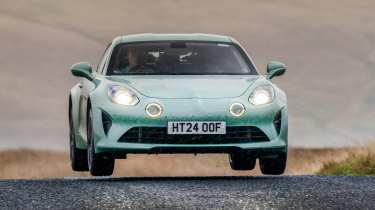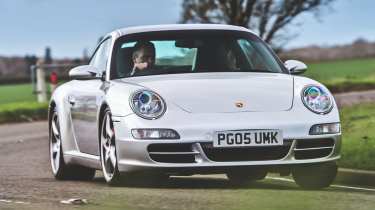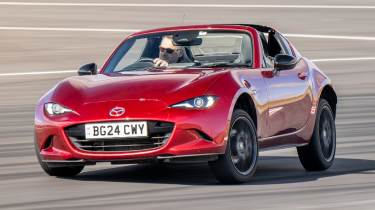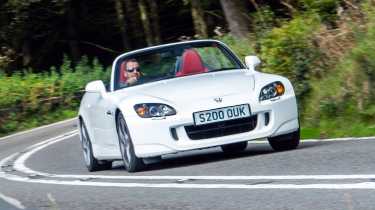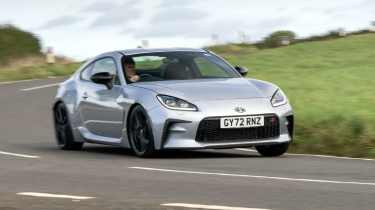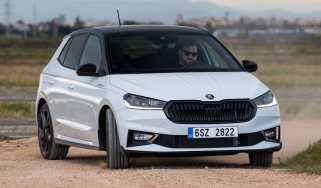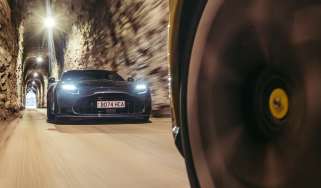Best used sports cars – driving thrillers for less than a new Audi RS3
With Summer in the rear view and Autumn in full swing, now’s the best time to buy a used sports car
The church of the sports car is a broad one. It encompasses everything from tiny two-seat roadsters with horsepower barely into triple figures, to pseudo supercars and GTs that unlike their more grownup counterparts, major more on driving thrills and dynamics than refinement, practicality, touring chops or indeed, outright performance.
Indeed, what unites all cars that can be described as a sports car, no matter the powerplant or badge atop their snout, is that they’re fundamentally aimed at delivering the thrill of driving above almost anything else. It should come as no surprise that the best sports cars are some of our favourite cars full stop.
They’re all also united by something else: they get cheaper when the clocks go back. Yes, it’s a well-known phenomenon that sports cars on the used market either take much longer to sell, or are priced a wedge lower from September onwards than they would have been when listed, say, in April, when we’re all on the hunt for a summer sports car fling. Now’s surely the perfect time to buy. Whether you’re spending £14k or £40k, there’s a pre-owned sports car to suit almost all budgets. All of our picks cost less than a new Audi RS3. Some are in the region of a quarter of the big warbling Audi…
1. Alpine A110
Prices from: £30k
Look out for: Filiform corrosion
See also: Mazda MX-5 (ND), Porsche Cayman 981 GTS
The Alpine A110 is getting a little long in the tooth and while that means its sad demise isn’t just inevitable, but imminent, it also means there are plenty of tempting pre-loved cars on the market. They’ve held value well for what it’s worth, with the earliest 249bhp 2017 and 2018 cars out there with some miles for around £30k, or a hair over half what they cost new. For less than the price of a middling hot hatch, it’s all the sports car many could ever want or need.
> Alpine A110 2025 review – one of the all-time sports car greats will soon be gone
If it was unique in 2017 for its extreme lightweight ethos, it’s borderline Alien now. Yet the novelty of what it offers hasn’t worn off. It’s still so tractable, so compliant and borderline ethereal in the way it can glide down a road. The earliest cars are esoteric in their setup, not being shy to lean under load. But this is part of what makes them so involving at far lower speeds than even the likes of a Porsche Cayman, which requires markedly more pace to feel like you’re working the chassis.
For those who want a bit more of a tied-down, focused set-up, not to mention a bit more power, the A110 S is just the trick. For our part, an A110 GT (296bhp a-la the A110 S with the ‘standard chassis’) is the Goldilocks A110, for sub-Golf GTI money at least. Even more so with some Life110 goodies and set-up. The (sublime) A110R is still very much above this pay grade.
An added joy of a lightweight car, especially in the used market? Reduced wear. A110s use tyres, brakes and bushings sparingly and drink fuel with a thirst far below most rivals, or M cars, or AMGs. Because they are so light on their feet, it’s no fierce battle with the laws of physics to get them moving, make them turn or make them stop. They’re relatively thin-of-tyre and small-of-brake too for this reason and thus, replacement consumables won’t cost you the Earth. Nor servicing, which for a 1.8-litre turbocharged four-cylinder engine that first saw service in the Renault Sport Megané, is entirely reasonably priced even from a main dealer. A110s aren’t beyond showing a few frills of filiform aluminium corrosion under the paint that while not structurally dangerous, it can look a little untidy.
2. Nissan 370Z Nismo
Prices from: £17k
Look out for: Accident damage, clunking suspension.
See also: Porsche Cayman 981, Toyota GT86
From the positively dainty A110, to the brutal, relatively ham-fisted Nissan 370Z Nismo. In the world of Japanese performance cars, it’s almost a muscle car. In our world, it’s that most British of recipes: big barrel-chested engine, long bonnet, seats not far off the rear axle, through which the brawn of the 339bhp V6 is exclusively sent. And preferably through a six-speed manual transmission that could replace the dumbbell rows in an upper body workout routine.
To drive they lack the delicacy and millimetric on-limit manipulability of say, a Cayman or an A110. But they are enormously involving cars that you don’t so much pilot as wrestle. You don’t savour the balance of the chassis so much as loud-pedal the car into sweeping, inward-facing cornering stances. You don’t so much relish the manual shift as repeat the first four ratios for reps on a sweeping B-road. The steering and body control aren’t to be savoured, nor the slightly industrial engine but there’s a cohesive brawler-like attitude to the whole thing that just works and holds enormous appeal.
Unlike the A110, the very hottest Nismo 370Z variants are within our self-imposed ‘less than a GTI’ budget, with earlier cars starting from less than £20k. For this you get aggressive Recaro seats, lots of red trim, a garish body kit (not that the standard Z was vanishingly elegant), a bump in performance, stiffer suspension and bigger brakes.
Being Japanese, the 370Z is supported by a thriving aftermarket so it’s relatively unique on this list in being a fruitful platform from which to build, if you’re so inclined. Apropos its modifiability, before long, you just know standard cars are going to start getting gobbled up and spat into tyre walls by learn-as-you-go drifters, as has been the case with the 350Z for a few years. It shouldn’t happen as much with the rarer, more expensive, more collectible Nismo.
3. Porsche Cayman GT4 (981)
Prices from: £55k
Look out for: Tired PASM, tired PADM, true mileage
See also: Lotus Evora 410 Sport, Alpine A110 R
Like goldilocks reaching the final bowl of porridge, a Cayman so often serves as the perfect all-round middle ground between. There’s a near-perfected balance to its chassis but with a still-delicate physicality to its controls. Any 981, no matter the level, has some kind of singing flat six-cylinder engine with more responsiveness and personality than most rivals. It is objectively the best all-round sports car, specifically in Porsche Motorsport-prepared Cayman GT4 form.
These were rightfully popular cars with 981 GT4 availability and variety always good on the used market in spite of their somewhat specialty billing. Prices range from around £60k, which is sturdy for this list of ‘bargains’. That said, as we found out during a recent comparison of four great six-cylinder sports cars from the last 25 years, there really is almost no substitute, from its own or any other era besides.
There aren’t many used sports cars that are as abundant and dependable as they are a safe place for your cash. You could pile miles on a GT4 and barely lose the equivalent of what a monthly payment or three on a new BMW M4 CS would cost. Over the years, the nicest GT4s will surely hold and rise. And of course, the Cayman ladder has worthy rungs below the GT4 too – the 335bhp 981 GTS is considered by many to be a sweet spot. Manuals aren’t in the greatest abundance but there are great cars out there for less than a new Golf GTI.
Being so popular (both Caymans and Porsches in general) there are plenty of specialists, so there are lots of festidiously-maintained, well-documented cars to choose from. If you want to get really adenoidal, you can even check what kinds of revs your chosen car has seen throughout its life via the famous black box check, which incidentally, is worth using to check the mileage too. 981s may lack the steering feel of the 987s they replaced but there are little to no worries to be had about bore scoring or bearing wear, as in the earlier cars. These are known to be generally solid cars, from the mechanicals to the way the interiors have worn. Be on the lookout for worn active engine mounts and passive dampers as these are inconveniently expensive to replace but otherwise, a 981 GT4 or any 981 really, is as all-round safe as it is satisfying a sports car bet.
4. Aston Martin V8 Vantage
Prices from: £18k
Look out for: Sportshift clutch life
See also: Audi R8 V8, Porsche 911 (997)
Safe isn’t always exciting and as good as Porsche Caymans are, isn’t a slightly self-destructive part of your brain always wondering how much Aston you can get for the same amount of money? The answer is quite a lot of V8 Vantage, Aston’s sports car that went toe-to-toe with Porsche’s 911 throughout the late-2000s and early 2010s.
Sporting an advanced extruded aluminium sub structure not unlike that first seen in the Lotus Elise, the 2000s Vantage was on a new level in its sophistication by comparison to, say, the last hand-built Vantages of the 1990s. That said, a Jaguar-derived V8 stroked out to 4.3 litres and 380bhp (latterly 4.7 litres and as much as 430bhp) with the vocal subtlety of an L85 assault rifle wasn’t exactly svelte or sophisticated. But this was Aston at its best – handsome, tightly put together but with a slightly brutish edge once opened up. Like a dog-eared rugby player in a Tom Ford three-piece.
> Aston Martin V8 Vantage (2005 - 2017) – Aston’s long-serving foil for the 911
What would leave some disappointed with V8 Vantages is that they don’t necessarily feel fast. You need the 420bhp 4.7-litre engine if this is a priority, as the 4.3s don’t get what is still a relatively porky car ( around 1500kg at the kerb) up the road at the most prodigious pace.
Vantages are fairly sturdy things given their exoticism and the reputation of their proprietor. That said, it’s worth keeping an eye on oil use. We’d recommend a manual car every single time but if you do for some reason want (or find yourself in) a Sportshift car, make sure the binder of paperwork includes a recent clutch change. This being an Aston Martin, the cost of maintenance is just generally higher, even at specialists.
5. Audi R8 V8
Prices from: £26k
Look out for: Timing chain issues, differential issues.
See also: Aston Martin V8 Vantage, Porsche 911 (997)
The arrow-straight and heavily patrolled roads around Las Vegas were not the perfect setting for Richard Meaden to make his first acquaintance with Audi’s then-new baby supercar back in 2007, but they revealed enough about it to conclude that the R8’s ‘dynamic ability and mouth-watering desirability’ would be enough to rattle Porsche. And this was the era when the 911 couldn’t lose a group test if it turned up with two leaky dampers and a missing brake caliper.
A couple of months later on the Côte d’Azur, the R8 saw off a perfectly fit 911 Carrera – as well as an Aston Martin V8 Vantage and a BMW M6 – in a comparison test that upended the sports coupe sector after decades of predictable (read: tedious) stability. The R8 was that good.
The sports car to supercar power-output latency seems to be around ten years, because the TT RS of a decade on got dangerously close to matching an early V8 R8 in the horsepower stakes. With 414bhp the older car still outgunned the 395bhp upstart, but the margin is pretty small and, given the TT’s swollen turbocharged torque and rapid-fire twin-clutch gearbox, the difference in straight-line performance is minimal in the real world. In every other dynamic sense, though, the R8 is streets ahead of the TT RS.
It’s still exceptional today, of course, and now around £30k is enough to buy a reasonably nice example. What made the R8 exceptional back then and keeps it so damn tempting now is its sweet chassis balance, crisp and intuitive steering, Lotus-like fluidity over tricky road surfaces, the click-clack of the open-gated manual ’box and, not least, the stirring soundtrack and immediate response of that 4.2-litre V8.
The R8 is shot through with supercar DNA, so it’s best to be weary of leggier, ropier cars at tempting low prices and keep a bit of cash in your back pocket ready for emergency maintenance. The V8 is highly-strung and must be maintained as such. Engine-out timing chain work, clutch changes (on the R-tronic) and dicky front differentials are regular forum talking points. A car with good service history and evidence of remedial work will give you the best peace of mind.
6. Porsche 911 (997)
Prices from: £25k
Look out for: Tired PASM, bore score, IMS bearing
See also: Aston Martin Vantage, Audi R8 (V8)
Truth be told, good used 911s are often the pin to burst many a hopeful new coupe’s bubble, for they are always perceived to be at least a league above whatever they’re compared with. Besides, Porsche’s rear-engined stalwart might be a bit of a cliché, but unless you simply can’t abide them, 911 ownership is a genuine and worthy aspiration for many.
You’d be crazy not to at least explore the notion of parking a Porsche 911 on your driveway. So which to choose? The 997 Carrera GTS should surely be almost impossible to resist, save for the irritatingly strong residual values.
> Used Porsche 911 (997, 2004-2012): review, history, specs and buying guide
There was always something special about this model, right from the off. Introduced in 2010, at the end of the 997’s life cycle, it could have been just another run-out model. Yes, it was laden with options to make it seem like irresistible value, but it was also a wide-body car fitted with the special Power Kit motor (good for 408bhp, and previously a ferociously expensive option), plus centre-lock wheels and a choice of manual or PDK transmissions. Further options included sports suspension, carbon-ceramic brakes and a limited-slip differential.
The 997 in general has relative cult status these days as the last small, properly feelsome 911. A fact reflected in solid residual values, even as the 991 rendered it obsolete. A quick scan of the online classifieds tells its own story. Early cars with their engine issues are attainable in the low-£20k range. At the other end of the scale, sub-£50k, 2010-on GTS examples are out there, but the very best can go as high as £70k. That’s something of a double-edged sword, both for buyers and existing owners. Such strong prices are hard to swallow when you’re buying, but it comes with the reassurance of zero depreciation or maybe continued (modest) appreciation.
The downside of chasing that particular rainbow is that it could well stop you using your car as freely as you’d otherwise like. For £10k or £20k less, a 997.2 Carrera S with a power kit and a few choice options isn’t less car to a significant extent. It’s probably the 997 sweet-spot now, on price.
Given the popularity of the Porsches and even the 997 specifically, there are plenty of specialists that know these cars inside and out. The GTS being a DFI car won’t suffer with bore scoring or IMS issues but carbon buildup is possible.
Earlier 997s aren’t actually as problematic as some will lead you to believe. Cars from 2006 and on had revised bearing designs to fend off the IMS issue that had already been improved upon in the change from 996 to 997. Get the oil of your chosen car dipped and maybe a bore scope – both should be forthcoming from the right specialists.
7. Mazda MX-5 RF 2.0
Prices from: £37,715 (new), £20k (used)
Look out for: A better car for under £40k? On used cars, crunchy gearboxes and corrosion.
See also: Honda S2000, Porsche Boxster GTS
Those who have read our 2024 evo Car of the Year test will know that we found the latest Mazda MX-5 to be resolved to a McLaren-equalling standard, as a device for enjoying driving. That’s how good it is.
Ten years on from its introduction, it’s never been better or more relevant. It’s better because Mazda has honed and fettled its roadster, adding trick dampers, uprated brakes and a refined limited-slip differential over the years, as well as improving the steering.
Why has it never been more relevant? Because most other cars have never been heavier or more distant in terms of driving feel, or more focused on raw performance numbers at the expense of interaction. Driving this feelsome, wieldy, lightweight sports car that’s all too happy to indulge you on almost any road you throw it at has never been more of a palate cleanser. In an MX-5 you just need so much less speed than in most supercars, to get the same amount of fun out of it.
> Mazda MX-5 RF 2025 review – evo Car of the Year 2024’s people’s champion
It’s the only car on this list we’d recommend buying new because A) the newest version is the best and B) £38k is a bit of a bargain for what you get. Remember, a Golf GTI is more expensive than this in 2025. Nonetheless, used NDs are still worthy options. Get into a 30th anniversary edition and you’ll still get 181bhp, the Bilstein Dampers, an LSD (albeit without variability on deceleration like the new car), the Brembo brakes and Recaro seats, all from £20k.
Of course being used, you’ll need to look out for maintenance history, as well as common issues. The manual gearboxes can have synchro issues and a bit of tinworm isn’t unheard of on the earliest NDs.
8. BMW Z4 M
Prices from: £14k
Look out for: Rod bearings, vanos pump, oil use
See also: Porsche Cayman/Boxster, Lotus Evora
It’s a shame when playing second fiddle to superior machinery in a segment means a good car is overlooked. The Porsche Boxster of the time was better than the BMW Z4 M of 2006, generally speaking. It handled better, had better balance and was more compliant on the road. But none of this is to say the BMW is totally incompetent or uninteresting or that it should be overlooked. That engine alone, the sublime 338bhp S54 of E46 M3 fame, makes the Z4 M a really compelling option all on its own.
They can be a bit spikey and they do ride a little rough but here is an involving, entertaining, engaging sports car that has perhaps one of the best-loved internal combustion engines of the 21st century. With the right modifications, you can conjure more than a few echoes of the McLaren F1 in the Z4 M’s aural accompaniment. Context also helps, for in today’s world of large, heavy cars, the Z4 (considered a bit broad and portly in its day) is positively diminutive. They’re good value today too, with even the nicest examples available for under £20k and some Roadsters (which incidentally ride a little better) available for as low as £10k. The TVR T350C, Porsche Cayman GT4 and Lotus Evora 400 Sport we compared the Z4 M with were better, but for at least double the money? That’s a tough call. The BMW offers monster bang for the buck.
> BMW Z4 M Coupe (2006 - 2008) review: a forgotten M car for £15k
There are of course the usual caveats to the prospect of old BMW ownership and old M car ownership. You’ve got to make sure your chosen example has been looked after well, with a fastidiously documented history of maintenance. If not you could run into engine issues especially – rod bearings are prone to wear, while the vanos pump is a known failure point. Make sure your chosen car isn’t too puffy from the exhaust when running, either. That could indicate undue oil use.
9. Honda S2000
Prices from: £8k
Look out for: Oil consumption, rust
See also: Mazda MX-5, Porsche Boxster, BMW Z4, Toyota GR86
The Honda S2000 is another car that hasn’t had the easiest time of it at the hands of our experienced critics. For sure, Honda’s frenetic roadster has its flaws, depending on how you look at it. It does require nothing less than 100 per cent commitment to get the best out of the chassis and engine.
For most of the time you’re driving it, the F20C 2-litre engine is something of a ponderous, gutless thing. But herein lay the pleasures of the S2000, if you are so inclined to seek and embrace them. And indeed, here lay some of the reasons why it’s one of the best used sports cars you can buy, certainly for the money they’re available from.
The F20C famously is good for a 9000rpm redline, at which point its retro-sci-fi digital dash will be aglow with orange, pinging on the right-hand side of the binnacle. Its relatively measly peak torque figure of 152lb ft will have only arrived 1500rpm earlier, its maximum power of 237bhp having only arrived 700rpm earlier.
But when you’re working the engine at its peak, needing to regularly slot up and down through one of the finest manual gear shifts out there to keep it on song, hanging onto the direct-in feel steering wheel (if indirect in its non-adjustable positioning), there are nirvana-like moments to be enjoyed if you’re a really keen driver.
The kicker is that these cars can be had for as little as £8k (for the ropier examples) or as little as £13k for a nicer car. For that, you get a redline and gear shift quality that matches a 911 GT3, in a handsome, reliable roadster. Yes, reliable. Beyond drinking a bit of oil and stretching their chains if you spend all your time battering the limiter, they go on forever. The biggest issue? Well, they’re Japanese, so they rust. They can also require gearbox work if they’ve had a hard life.
10. Lotus Elise S1
Prices from: £18k
Look out for: Tired suspension and chassis, ropey repairs, engine health
See also: Mk3 Toyota MR2, Porsche Boxster, Caterham Seven
The Elise might just go down as the greatest car Lotus ever made and the reasons for such an appraisal are innumerable. The bonded extruded aluminium structure is the stuff of genius, informing the versatility and light weight that all Elises and cars based on this design enjoyed. Its significance has echoed throughout the industry – near enough Aston Martin’s entire 21st-century lineup, to name just one example.
> Used Lotus Elise (S1, 1996-2001) review – a world-beating sports car for supermini money
To drive, there’s a physicality to its snickety manual transmission while the unassisted steering brims with feel once you’ve got the car loaded up. Quite unlike the heaviest performance cars of today, there’s a sense of joy in feeling the car’s balance; in counting every one of its kilograms and the contribution they have to how it rolls and leans and moves around. Because of course, there are so few of those kilograms – 770kg dry if you’re in a Sport 160, 731kg dry if you’re in the 118bhp original.
The Elise is the oldest car on this list, which could be a bit of worry when you consider the popular acronym ‘Lots of trouble, usually serious’. Happily, they are well-known cars that many specialise in looking after. The K-series, while notorious for its head gasket issues, is no enigma, with a number of solutions to its problems devised these last 25 years. Time and expertise has cured perhaps the Elise’s biggest flaw – how susceptible they are to setup. Those in the know will help you get it right and unlock the exceptional sports car that lives within every Elise, that can feel so distant when driving a tired one. The lightweight glassfibre bodywork is difficult to repair too, so look out for shoddy workmanship on the lower-end examples.
11. Toyota GR86
Prices from: £26k
Look out for: Accident damage
See also: Porsche Cayman, Alpine A110
The Toyota GR86 might just be our favourite bare-bones sports car of the last decade. The GT86 got off to a good start but its slightly gutless engine, notchy gearchange and slightly too loose attitude stopped short of true greatness. The GR86, with its meatier 231bhp 2.4-litre engine, improved gear shift and better-resolved body control and chassis feel, pretty much nailed it.
The flat-four is still arguably the weak point. It’s not the revviest personality to conduct with those six manual gears and three pedals but it is at least a more effective motive device than its predecessor. It brings to life a chassis made of magic, that distills the basic joys of driving into a roundly competent junior coupe. It’s a car you could learn to drive in and spend a lifetime exploring the balance and nuances of and not get bored.
The GR86 is sadly off-sale now and the limited numbers in which they were supplied means prices are sturdy. You won’t pay any less than £26k (at the time of writing) for a respectable example, just £4k less than they cost when new in 2022 and 2023. Happily, being so new means there aren’t many issues to speak of. Just avoid cars that have been crashed, poorly maintained and that feel tired in terms of their shift quality and suspension compliance. Now as when new, they’re one of the best sports cars money can buy.
TVR T350
Prices from: £30k
Look out for: Delicate engines, electrics, paint, plenty besides
See also: BMW Z4M, Porsche Cayman, Lotus Evora
Contemplating the fact that the last new customer TVR was produced in Blackpool almost 20 years ago does nothing for how old you feel. But as we found out when we were reacquainted with a T350C in a gathering of epic six-cylinder sports cars, those 2000s Trevors are still fast, fun and thrilling today. Raw, though – they were by 2000s standards so by today’s, the T350C could be uncharitably described as positively abrasive. But that’s sort of the point. There are no assists, there’s no cruise control, no Apple CarPlay. The job always at hand when aboard the T350C, is that of driving it. And it’s an all-encompassing one.
> Used TVR T350 (2002 - 2006) review: an exotic British icon for £30k
Save for the slightly sharp, feel-bereft steering and the somewhat lacklustre body control, it demands that you learn it, optimise your inputs, and speak its language. Once you’re on its level, once you’re dialled in, the clouds clear and it all comes together. That’s before you’ve even contemplated the engine, a bespoke straight-six of TVR’s own design, that has more personality in its injection system than most modern alternatives bring altogether.
For being as exotic and esoteric as it is, prices for TVR T350s are strangely soft – £30 - £40k is the realm in which most sit. You’ll want a cushion of extra cash in your back pocket for rainy days however. The Speed Six engines are far from bombproof and can be as capricious in terms of their reliability as the spiky T350 is to drive. Everything about these old TVRs is a little bit weird and in need of specialists should issues arise, even the wild paint.
Lotus Evora 410 Sport
Prices from: £45k
Look out for: Dicky electrics, a winey gearbox
See also: BMW Z4M, Porsche Cayman, TVR T350C
Rarely does a Lotus look conventional but the Evora 410 Sport, as it was on the test next to the TVR T350C, is an almost welcome dose of Toyota-powered (albeit supercharged) vanilla by comparison. We’ve loved the Evora since its introduction in 2009 (when it won eCoty, no less) but few could have foreseen what the Evora would become. The Evora 400 and its derivatives were a notch up and a compelling (if quite expensive) alternative to the fairly standard Porsche Cayman fare of the mid-2010s.
> Used Lotus Evora (2009 - 2021) review: an everyday sports car for hot hatch money
In terms of its dynamics however, it’s right on the money. Stiffer Bilstein dampers add a bit of focus (and shave a hair of compliance, admittedly) while the balance is transparent and steering feelsome. The Evora was always a car that felt like it could handle more power, with even the 410bhp of the 410 Sport falling a little short of giving the Evora anything like the hot rod feel of the TVR. Nonetheless, 4.2sec to 62mph on the way to a 190mph top speed is properly good going. If only the engine were a bit more exotic in terms of its vocals, and responsive to stabs of the throttle.
They might have been considered expensive when new (£20k more than Porsche’s GT4 in 2016) but they’ve softened nicely in recent years. A 2017 410 Sport like the car we tested is now a £45k - £55k prospect – usefully cheaper than a new Emira for over £95k. The usual issues you’d associate with Lotus can arise – build quality, electrical niggles – but the Toyota-based V6 engine is a faithful performer.


